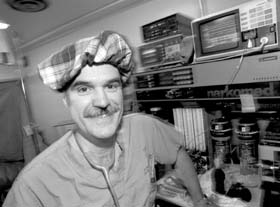
| ||
 | ||
 Anesthesia professor Dr. Gilles Plourde PHOTO: OWEN EGAN |
Awake under the knife
|
HÉLÈNA KATZ | Imagine waking up during your own surgery. You can't open your eyes or talk -- a result of paralysis caused by drugs that were part of the anesthetic you received. But you can hear what's happening in the operating room and you have some sensation of what the surgeon is doing. An almost impossible occurrence? It happens to between 40,000 and 250,000 Americans each year. While most drift back to unconsciousness, a small percentage of these patients endure a horrific experience -- they lie on the operating table terrified and in pain, but with no way of telling the surgical team that they can feel everything that's happening. Royal Victoria Hospital anesthetist Dr. Gilles Plourde recalls one patient who woke up during two different operations. The first time was during a gall bladder procedure and the second was 20 years later during cardiac surgery. Although she didn't feel pain, "she felt pressure and touching around her heart and could describe in minute detail what the surgeon was doing," says Plourde. Of the patients who do regain some level of consciousness during their operations, only two percent of them become sufficiently awake to remember the experience afterwards, says Plourde. Still, even a few is too many. Patients who remember suffering through painful surgery after re-awakening may go on to develop post-traumatic stress disorder, suffering through symptoms such as anxiety, insomnia, nightmares and emotional problems. "They can become very angry and upset, especially if they feel it occurred because of negligence or they heard unacceptable comments during the surgery," Plourde says. They are also likely to become understandably nervous and reluctant should they ever need more surgery. They often become mistrustful of all doctors. Part of the difficulty for anesthetists is that they lack precise methods for monitoring a patient's unconscious state -- there is no machine for measuring just how unconscious someone is. Plourde is trying to change that. He is conducting research into ways of determining whether a patient is regaining consciousness. A senior clinical scholar with funding from the Fonds de la Recherche en Santé du Québec, he has been working with fellow McGill anesthesia professors Drs. Steve Backman and Pierre Fiset for the past few years and more recently with pain expert Dr. Catherine Bushnell, McGill's Harold Griffith Professor of Anesthesia. As things stand now, even though anesthetics almost always do their work properly, anesthetists have to be vigilant for the slightest sign that a patient is coming to. For instance, Plourde says that patients generally receive muscle relaxants. As it wears off, a patient can move her leg from side to side -- this type of motion requires little force -- which alerts the anesthetist that they're regaining consciousness. The most common reason that people regain consciousness is that the delivery of an anesthetic is accidentally interrupted, Plourde says. "A syringe gets disconnected, a pump malfunctions or gets blocked," he explains. "So it has nothing to do with the person." Doses of anesthetic can be deliberately reduced for life-threatening conditions, like surgery for trauma patients. A patient's chronic use of alcohol, sleeping pills, tranquilizers or illicit drugs increases their tolerance for anesthetic agents, reducing their effectiveness. When Plourde, who studied neurology before deciding to specialize in anesthesia, began work in his current line of research, he wanted to look beyond the studies in neurophysiology literature that examined relationships between brainwave activity and levels of consciousness -- when a person is dreaming, for instance. Plourde's studies try to take a more global approach than most earlier work which generally focused on one specific part of the brain, such as the hippocampus. He and his colleagues are looking at different sorts of brain activity, and examining what happens when anesthetics are introduced. "We are taking what was known and we've decided to examine what the effects of anesthetics [would be] on certain measures which seem to be influenced by the level of consciousness," he says. "If you need one percent of a drug to induce unconsciousness and you see changes in the brain structure at three percent, you can't say they're related to loss of consciousness because you should've seen that phenomenon at one percent," Plourde explains. Three years ago, Plourde and Fiset began using brain imaging, through the McConnell Brain Imaging Centre at the Montreal Neurological Institute, to see which parts of the brain are active depending on different levels of consciousness. Plourde's team has examined one indicator in humans that shows signs of being particularly sensitive to anesthetic -- something called the 40 Hertz auditory steady-state response. Plourde and his team deliver a burst of 40-Hz of sound -- resembling a telephone ringing -- to an anesthetized volunteer every minute. Electrodes on the person's scalp detect the brain's response seen in the electroencephalogram. "By the time the person is unconscious, the response is either gone or very attenuated," he says. Individuals can detect the sound when they're regaining consciousness. While the monitoring device's prototype is the size of a dresser, a smaller, recently completed version resembles an EKG monitor. Plourde, who has been conducting research on the 40-Hz auditory steady-state response for the past 10 years, says his work was one of the first studies of its kind on humans. Although having one of his monitoring devices in every operating room "would be a nice accomplishment," the technique's effectiveness must first be proven beyond a shadow of a doubt, he says.
|
|
| |||||